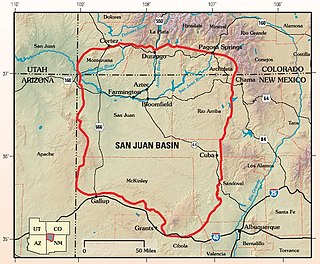Related Research Articles

The San Juan Basin is a geologic structural basin located near the Four Corners region of the Southwestern United States. The basin covers 7,500 square miles and resides in northwestern New Mexico, southwestern Colorado, and parts of Utah and Arizona. Specifically, the basin occupies space in the San Juan, Rio Arriba, Sandoval, and McKinley counties in New Mexico, and La Plata and Archuleta counties in Colorado. The basin extends roughly 100 miles (160 km) N-S and 90 miles (140 km) E-W.
The Hesbaye Group is a stratigraphic group in the subsurface of northeastern Belgium. This group was deposited during the early Paleocene epoch and is subdivided into two formations: the Houthem Formation (lower) and the Opglabbeek Formation (upper). The group is named after the region of Hesbaye in the south of Limburg.
The Opglabbeek Formation is a geologic formation in the subsurface of the eastern part of Belgian Limburg. The heterogeneous formation consists of clay and sand that was deposited lagoonally and fluvially during the early Selandian. The formation is named after the town of Opglabbeek in Limburg.
The Hannut Formation is a geologic formation in the subsurface of northern Belgium. The formation consists of marine clay and silt, alternating with more sandy layers. On top of this the lithology changes to limestone, siltstone and sandstone and the top of the formation is formed by a layer of glauconite bearing sand. The Hannut Formation was formed during the early to middle Thanetian age.
The Heers Formation is a geologic formation in the subsurface of Belgium. The formation consists of sand and marl and was deposited in the shallow sea that covered Belgium during the middle to late Selandian age of the Paleocene epoch.
The Ieper Group is a group of rock strata in the subsurface of northwest Belgium. The group is subdivided into three marine formations, all formed during the Ypresian, a single age of the geologic timescale. Both age and group are named after the West Flemish town of Ypres, for which the Dutch name is "Ieper".
The Dongen Formation is a geologic formation in the subsurface of the Netherlands. The formation consists of early Eocene marine clay and sand. It is named after the town of Dongen in North Brabant.
The Rupel Formation is a geologic formation in the subsurface of the Netherlands that consists of Oligocene marine sands and clays. The Rupel Formation is part of the Middle North Sea Group and correlates exactly with the Belgian Rupel Group.
The Rupel Group is a stratigraphic group of rock strata in the subsurface of Belgium. It is subdivided into three formations that are all marine deposits of Oligocene age.

The Breda Formation is a geologic formation in the subsurface of the Netherlands. The formation consists of marine glauconiferous sands and clays that were deposited during the Miocene epoch. Although the formation is not very rich in fossils, sometimes bones of fishes, mammals, shells and shark teeth are found.
The Zenne Group is a group of rock strata in the subsurface of central and northwest Belgium. The group consists of three formations, all from the Ypresian and Lutetian ages. These formation have their shallow marine facies in common.
The Aalter Formation is a geologic formation in the subsurface of northwest Belgium. The formation consists of marine clay and sand, deposited in the shallow sea that covered northern and central Belgium in the Eocene epoch.
The Gentbrugge Formation is a geologic formation in the west of Belgium. The formation crops out in East Flanders and West Flanders and also occurs in the subsurface of the Province of Antwerp. It consists of marine clay, silt and sand, deposited in the shallow sea that covered northern Belgium during the Ypresian age.
The Tielt Formation is a geologic formation in the subsurface of Belgium. The formation crops out in the north of Hainaut, in the southern and central parts of West- and East Flanders and in Walloon and Flemish Brabant. It consists of marine very fine sand and silt, deposited in the shallow sea that covered Belgium during the middle and late Ypresian age.
The Kortrijk Formation is a geologic formation in the Belgian subsurface. This formation crops out in northern Hainaut, southern West and East Flanders and in Walloon Brabant. The formation consists of marine clay from the Ypresian age.
The Veldhoven Formation is a geologic formation in the subsurface of the Netherlands. The formation consists of an alternation of marine clay and sand from the Oligocene epoch.
The Voort Formation or Voort Member is a stratigraphic unit in the subsurface of north Belgium and the south of the Netherlands. The unit has the status of a formation in Belgium but is seen as a member of the Veldhoven Formation in the Netherlands. The Voort Formation consists of shallow marine sands with a late Oligocene age.
The Maldegem Formation is a geologic formation in the Belgian subsurface. The formation consists of alternating marine clay and sand strata, deposited during the late Eocene.
The Lede Formation is a geologic formation in the subsurface of Belgium. The formation is named after the town of Lede in East Flanders. It consists of shallow-marine limestone and sandstone, deposited in the former sea that covered Belgium during the Eocene.
The Tongeren Group is a lithostratigraphic unit in the subsurface of Belgium. It consists of shallow marine, epicontinental and/or continental clays and sands from the late Eocene to early Oligocene epochs.
References
Bibliography
- Laga, P.; Louwye, S. & Geets, S. (eds.); 2001: Paleogene and Neogene lithostratigraphic units (Belgium), Geologica Belgica 4(1-2), p. 135-152